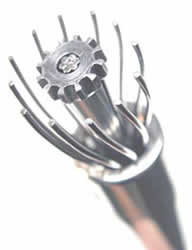Wire Rigging
Wire standing rigging is one of the most maintenance free aspects of modern sailboats. However, since relatively little attention is required, many sailors are not well informed about their shrouds and stays. We help our customers understand what wire rope can and cannot do, as well as what can be done to help it perform as well, and for as long as possible. Rigworks has the capacity to swage up to 5/8″ marine swages.

Hayn Hi-mod mechanical fitiing
While all marine rigging is made of stainless, no steel is completely impervious to corrosion or rusting. Generally the more nickel in the alloy, the more “stainless” it will be. But adding nickel actually weakens the metal a bit – getting the right mix is the key. Better riggers agree that 316 grade stainless is the right choice for the marine environment. While less expensive 304 actually has a higher breaking strength when new (less nickel), it weakens significantly after a few years of salt water service. Rigworks constructs all standing rigging from 316, and uses 304 only for indoor architectural projects.
The architecture of wire rope is also key to its performance. Hopefully, your heaviest crew member doesn’t work the foredeck and your lightweights don’t do all the grinding. Similarly, some wire is constructed for pure strength, while other constructions give up a bit of strength in favor of flexibility. Generally, wire standing rigging has a 10-12 year life cycle in normal conditions and use, but it is less in the tropics.
1×19
Most shrouds and stays are made of 1×19 cable. This cable is laid up in one strand comprised of 19 smaller strands. It is very strong, not very flexible, and works very well with the various fittings which may be swaged on its cut ends. This cable is generally used for shrouds and/or standing rigging.
Dyform / Compact Strand
Compacted wire rope, commonly called Dyform, is stronger and exhibits less stretch. More on Compacted/Dyform wire.
7×19
At the other end of the spectrum is 7×19 cable. Being constructed of seven strands each containing nineteen smaller strands, it is very flexible and therefore appropriate for halyards, dinghy hoists, etc. (These days the demand for flexible wire is decreasing quickly due to today’s incredibly strong and more hands-friendly line. Please see our rope selection.)
7×7
Finally, there is vinyl coated wire, commonly a 7×7 wire, and used for lifelines. This is mostly a matter of tradition, but it’s worth noting that uncovered 1×19 is quickly becoming the standard for lifelines on finer yachts. More on Lifelines.